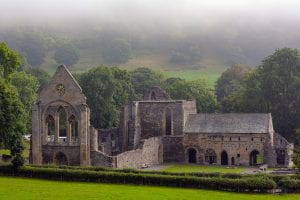
A five-year research project to explore the history and literature of the medieval March of Wales began on 1 May 2023, based at the University of Bristol. The project is called ‘The Medieval March of Wales, c. 1282–1550: Mapping Literary Geography in a British Border Region’, known as MOWLIT for short.
The project aims to create the first cultural history of the medieval March of Wales, the borderlands between Wales and England, occupied by a diverse population of Welsh, English and French speakers in the period between 1282 and 1550. The main objectives are to uncover and analyse the literary texts and manuscripts produced and circulated in the medieval March, and to create an original series of digital maps of the Marcher lordships at various date points during the period. The texts and the maps will be linked by means of a prosopography, a visualisation of the major gentry houses and abbeys, and a distribution of the texts/manuscripts across the maps showing where they were produced and who read/owned them. These resources will enable an assessment of the cultural and regional identities of the March and its relations with its more powerful neighbour, England.
The project team includes heritage and mapping specialists from the Royal Commission of Ancient and Historic Monuments in Wales and digital humanities specialists from Research IT at the University of Bristol. The project will employ two full-time postdoctoral research assistants and an administrator, and will support a PhD studentship. Outcomes from the project include a monograph, two edited collections, digital and printed maps, and a PhD thesis suitable for publication. You can read more about the project at the MOWLIT website which we have recently set up and which will be added to with new materials at regular intervals.
The project was originally awarded funding through the ERC Advanced Grant scheme and is now funded through the UKRI guarantee.
We aim to engage with local history groups, museums, creative practitioners and other stakeholders with an interest in the region of the March and its history. Please get in touch if you would like to be added to the mailing list to be kept up to date with the project and its activities.
Helen
Helen.fulton@bristol.ac.uk

I know something about the complexity of the medieval Marches, and I very much enjoyed the podcast.
The extent to which originally-English families engaged with Welsh culture interested me, although I knew about intermarriage; I was perhaps a little surprised that Owain Glyndŵr was not mentioned as an example: the archetypal Welsh hero, yet he served in the Scottish wars and his family married into English families. And his rebellion united Wales more than the Welsh princes had managed, with their own dynastic ambitions.
Comparisons with other European frontier zones were mentioned; Ireland springs to mind, but which other regions are included?
Hello Philip, thanks so much for writing. I agree that Owain Glyndŵr is an important figure, given his links with English politics and nobility. Regarding other European frontier zones, we will be talking to other scholars in France, Germany and Eastern Europe about key border regions, medieval and modern, and issues of identity over time. Do email me directly if you would like to be added to the project mailing list.
I have been trying to find academic scholarship on the March of Wales lordship in western Shropshire that included the manor of Brogyntyn. I believe it was the Lordship of Whittington. I have found many interesting and useful sources covering marcher lordships in the period that ended with the Edwardian conquest of the Principality of Wales, but I have not found any material looking at the fifteenth century in this area. Could you recommend any reading for me? In return, would you like to know about a manuscript, produced in Warwickshire in the 1460s, that circulated in Wales and/or the March in the sixteenth and seventeenth centuries? Nancy P. Pope, Ph.D., Washington University in St. Louis (Retired)
Dear Nancy, thanks so much for your message. The best books to start with are those by R. R. Davies, one called Lordship and Society in the March of Wales, and the other called The Age of Conquest: Wales 1063–1415. These books cover the period up to the early fifteenth century. Regarding the specific area of Whittington, you could look at the journal called Shropshire History and Archaeology: Transactions of the Shropshire Archaeological and Historical Society. Volumes 77 and 79 contain articles relating to Whittington, and there are probably earlier volumes that also contain relevant material. Most of the volumes are available online here: https://shropshirearchaeologyhistory.org/publications/our-library/past-transaction-volumes/
I would certainly be interested in hearing about the Warwickshire manuscript! Please feel free to email me directly at Helen.fulton@bristol.ac.uk
Best wishes, and thanks so much for your interest in the Marches project. Let me know if you would like to be added to our mailing list. Helen.